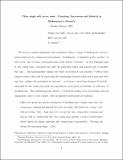'Thou single wilt prove none': Counting, Succession and Identity in Shakespeare's Sonnets
Author(s)
Raman, Shankar
DownloadRaman-Arden.pdf (190.3Kb)
OPEN_ACCESS_POLICY
Open Access Policy
Creative Commons Attribution-Noncommercial-Share Alike
Terms of use
Metadata
Show full item recordAbstract
he need to conjoin singularity and exemplarity drives a range of Shakespeare’s procreation sonnets in the young man sub-sequence. Standing for “a singularly perfect nature” as well as for “the yet more total perfection of the Nature of nature,” as Joel Fineman putsit, the young man “represents not only the particular token and general type of ideality, but, also . . . the harmoniously organic way these are related to one another.” Often, these sonnets achieve their end by projecting the relationship between ideal and actual onto biology; they conflate the metaphysical “pattern” – to borrow a word from Sonnets 19 and 98 –
embodied by the young man with the reproductive generation, potentially
ad infinitum, of his likenesses. This underlying logic derives, as Fineman further notes in passing, from an engagement, more or less explicit, with an inherited mathematical tradition: Only if we grant the unitary arithmetic of idealism does it make sense that the young man, multiplying himself after his own kind, will father the “many” that will prove him “One.” And only if we accept the tidy categoriality of genus and species will we understand how the young man spawns a series of particulars whose lineal succession embodies the young man’s universality: “Proving his
beauty by succession thine.” (251) Fineman’s evidentiary instance comes from Sonnet 2, where the notion of “succession” brings together the biological iteration of sameness with the sequential unfolding of cardinal numbers, “proving” the currency of this “unitary arithmetic” by opening a passage between the idea of a (real) biological series (“like father, like son”) and the series of whole numbers, based on the repeated addition of the idealised unit or the one.
Date issued
2017Department
Massachusetts Institute of Technology. Department of Humanities. Literature SectionJournal
The Sonnets: The State of Play
Publisher
Bloomsbury Publishing
Citation
Raman, Shankar. "'Thou single wilt prove none': Counting, Succession and Identity in Shakespeare's Sonnets." The Sonnets: The State of Play, ed. Elizabeth Baumann and Hannah Crawforth, Bloomsbury Publishing, 2017 © 2017 Bloomsbury Publishing
Version: Author's final manuscript
ISBN
9781474277143